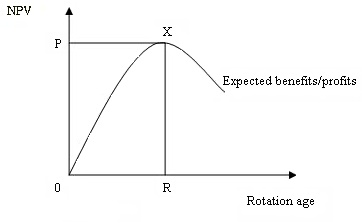|
Mean Annual Increment
The mean annual increment (MAI) or mean annual growth refers to the average growth per year a tree or stand of trees has exhibited/experienced up to a specified age. For example, a 20-year-old tree that has a stem volume of has an MAI of /year. MAI is calculated as MAI=Y(t)/t where Y(t) = yield at time t. For a stand of trees the total stem volume (m3) per area (ha) is typically calculated. Because the typical growth pattern of a forest is sigmoidal, the MAI starts out small, increases to a maximum value as the trees mature, then declines slowly over time as some trees' canopies face competition for sunlight and older trees die off. Throughout this, the MAI always remains positive. MAI differs from periodic annual increment In forestry, periodic annual increment (PAI) is the change in the size of a tree between the beginning and ending of a growth period, divided by the number of years that was designated as the growing period. For sigmoid growth, the graph of PAI inc ... (PAI) ... [...More Info...] [...Related Items...] OR: [Wikipedia] [Google] [Baidu] |
Forest Stand
A forest stand is a contiguous community of trees sufficiently uniform in composition, structure, age, size, class, distribution, spatial arrangement, site quality, condition, or location to distinguish it from adjacent communities. A forest is a "collection of stands" also utilizing the practices of forestry. Stand level modelling is a type of modelling in the forest sciences in which the main unit is a forested stand. Stand description A forest stand is commonly described as in 10ths or 10%s. Thus a ratio could be given of: 3 Ponderosa pines, 2 mangrove trees, 5 silver spruces. If there was a mixed stand that stand mix could be described as mixed up to 10%, mixed 10–40% and a mixed stand over that amount. The form of mixing of the tree types is commonly given as: * individuals – when there are a few unconnected trees of a type. * troop – up to 5 trees connected of one type. * group – when there are more than 5 trees, but they are shorter than a harvestable tree. * ... [...More Info...] [...Related Items...] OR: [Wikipedia] [Google] [Baidu] |
Sigmoid Function
A sigmoid function is a mathematical function having a characteristic "S"-shaped curve or sigmoid curve. A common example of a sigmoid function is the logistic function shown in the first figure and defined by the formula: :S(x) = \frac = \frac=1-S(-x). Other standard sigmoid functions are given in the Examples section. In some fields, most notably in the context of artificial neural networks, the term "sigmoid function" is used as an alias for the logistic function. Special cases of the sigmoid function include the Gompertz curve (used in modeling systems that saturate at large values of x) and the ogee curve (used in the spillway of some dams). Sigmoid functions have domain of all real numbers, with return (response) value commonly monotonically increasing but could be decreasing. Sigmoid functions most often show a return value (y axis) in the range 0 to 1. Another commonly used range is from −1 to 1. A wide variety of sigmoid functions including the logistic and ... [...More Info...] [...Related Items...] OR: [Wikipedia] [Google] [Baidu] |
Periodic Annual Increment
In forestry, periodic annual increment (PAI) is the change in the size of a tree between the beginning and ending of a growth period, divided by the number of years that was designated as the growing period. For sigmoid growth, the graph of PAI increases rapidly and then quickly declines, approaching zero. PAI may go negative if a tree loses volume due to damage or disease. Periodic annual increment is commonly used instead of current annual increment as a basis for computing growth ''per cent''. Growth ''per cent'' indicates the rate of increase with relation to the wood capital required for its production, this is usually based on a single year's growth.Chapman, H.H.,1921, Forest Mensuration, second edition. p315 New York: Wiley & Sons, Inc. Equation PAI= \frac Where: Y is the yield (volume, height, DBH, etc.) at times 1 and 2 and T1 represents the year starting the growth period, and T2 is the end year. Example: Say that the growth period is from age 5 to age 10, and ... [...More Info...] [...Related Items...] OR: [Wikipedia] [Google] [Baidu] |
Optimal Rotation Age
In forestry, the optimal rotation age is the growth period required to derive maximum value from a stand of timber. The calculation of this period is specific to each stand and to the economic and sustainability goals of the harvester. Economically optimum rotation age In forestry rotation analysis, economically optimum rotation can be defined as “that age of rotation when the harvest of stumpage will generate the maximum revenue or economic yield”. In an economically optimum forest rotation analysis, the decision regarding optimum rotation age is undertake by calculating the maximum net present value. It can be shown as follows: *Revenue (R) = Volume × Price *Cost (C) = Cost of harvesting + handling. *Hence, Profit = Revenue − Cost. Since the benefit is generated over multiple years, it is necessary to calculate that particular age of harvesting which will generate the maximum revenue. The age of maximum revenue is calculated by discounting for future expected benefit ... [...More Info...] [...Related Items...] OR: [Wikipedia] [Google] [Baidu] |

